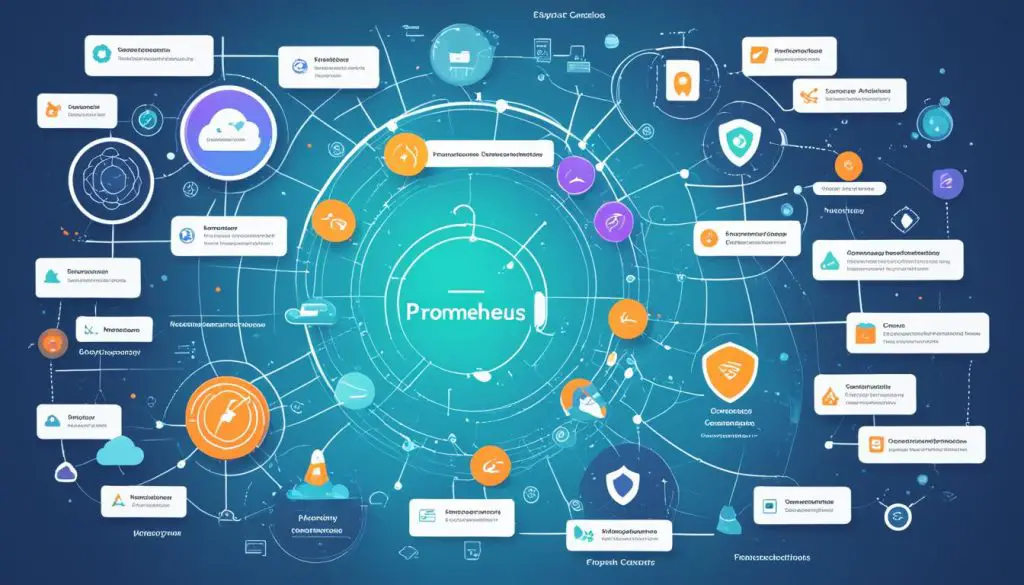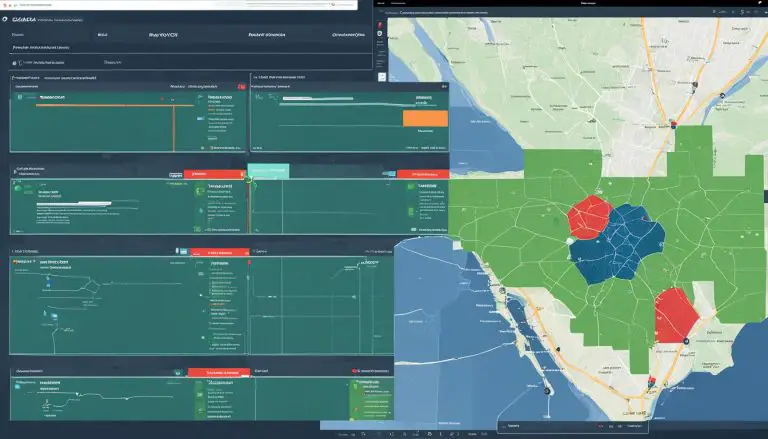Comparing Prometheus vs. Icinga for Monitoring Needs
When it comes to monitoring tools, Prometheus and Icinga are two popular options that come to mind. But which one is the right choice for your monitoring needs? Are their capabilities and features really that different? Let’s dive in and explore the key differences between Prometheus and Icinga to help you make an informed decision.
Key Takeaways:
- Prometheus and Icinga have distinct approaches and capabilities for monitoring system health and performance.
- Icinga primarily relies on active checks, while Prometheus follows a pull-based model.
- Prometheus has its own local time-series database, making it self-sufficient in terms of data storage.
- Both tools have alerting systems, but Prometheus offers more flexibility and integration with its data collection and query language.
- While Icinga requires external tools for querying and visualization, Prometheus has its own query language and built-in visualization capabilities.
Now, let’s dig deeper into the specifics of data collection, storage, alerting, querying, scalability, and ecosystem integrations to uncover which tool best fits your monitoring requirements.
Data Collection and Monitoring Approach
When it comes to monitoring the health and performance of services and systems, Prometheus and Icinga offer unique approaches. Let’s explore how these two monitoring tools handle data collection and monitoring.
Active Checks and Metrics Collection
Icinga relies primarily on active checks to monitor various services and systems. It executes check scripts that gather state, output, and performance data metrics. These metrics are then collected and utilized for further monitoring and notifications. With Icinga’s active check model, users have more control over when and how often checks are performed, allowing for real-time monitoring.
On the other hand, Prometheus follows a pull-based model for data collection. It scrapes metrics from target systems by periodically querying them. This approach enables Prometheus to check process performance over time and store the discovered metrics. The collected metrics can then be used to create queries for alerts and analysis.
Flexibility and Scalability
One of the key benefits of Prometheus’s pull-based approach is its flexibility and scalability. Since Prometheus periodically queries systems for metrics, it can handle dynamic environments with ease. This makes Prometheus a preferred choice for systems that require frequent monitoring and scalability.
Icinga’s active check model, on the other hand, provides users with greater control over when and how often checks are performed. This can be beneficial for environments that require precise monitoring and customized alerting strategies.
By adopting Prometheus, users can enjoy the benefits of a flexible and scalable monitoring tool. The pull-based approach allows for efficient data collection and analysis, making it ideal for large-scale and dynamic environments.
In contrast, Icinga’s active check model provides users with finer control over monitoring. It excels in environments where customized alerting and precise monitoring are paramount.
Next, we will explore how Prometheus and Icinga handle data storage and persistence, which play a crucial role in the monitoring process.
Data Storage and Persistence
When it comes to data storage and persistence, there is a significant difference between Prometheus and Icinga. While Icinga relies on external databases like MySQL or PostgreSQL to store monitoring data, Prometheus has its own local time-series database. This built-in storage system simplifies the deployment of Prometheus and eliminates the need for external databases.
Prometheus stores all collected metrics by default, making it easier for users to access and analyze historical data. This means that all the valuable information about system health and performance is readily available within the Prometheus monitoring system. On the other hand, Icinga does not have its own storage mechanism, requiring users to set up and maintain external databases for storing monitoring data.
This difference in data storage and persistence gives Prometheus an edge when it comes to convenience and usability. With its built-in database, Prometheus provides a seamless experience for monitoring and analyzing system metrics, eliminating the complexity of additional database installations and configurations.
Furthermore, the local time-series database in Prometheus allows users to efficiently handle large amounts of monitoring data. This is particularly beneficial in environments with high-volume metrics, as Prometheus can handle the storage and retrieval of data efficiently within its own system.
In contrast, Icinga relies on external databases, which may introduce additional complexity and potential bottlenecks when dealing with large amounts of monitoring data. This dependency on external databases for storage can impact performance and scalability, especially in environments with extensive monitoring requirements.
Overall, the difference in data storage and persistence sets Prometheus apart from Icinga in terms of convenience, efficiency, and scalability. Prometheus’s built-in time-series database simplifies the deployment process and ensures easy access to historical data for analysis. In contrast, Icinga’s reliance on external databases can introduce complexity and potentially hinder performance.
Alerting and Notification System
Both Prometheus and Icinga have their own alerting systems, but they differ in their approach and capabilities. Icinga’s alerting system allows users to set up custom-defined alerts based on thresholds, patterns, or specific conditions. This flexibility enables users to tailor their alerting rules to their specific needs. Additionally, Icinga supports various notification methods, including email, SMS, and integration with popular chat platforms such as Slack or Microsoft Teams.
On the other hand, Prometheus takes a different approach to alerting and notification. Its alerting system is tightly integrated with its data collection and utilizes its powerful query language, PromQL. This integration allows users to define alerting rules based on metrics and perform complex queries to create more sophisticated alerts. Prometheus’ alerting system empowers users to set up granular and dynamic alerting rules, ensuring that they receive notifications only when specific conditions are met.
Icinga’s customizable alerts and flexible notification methods make it a versatile tool in various scenarios. The ability to set up custom-defined alerts based on specific thresholds or patterns allows for proactive monitoring and timely issue resolution. Additionally, the integration with popular chat platforms enhances team collaboration and facilitates efficient incident response.
Prometheus’ alerting system, with its tight integration with data collection and powerful query language, provides advanced alerting capabilities. The ability to define alerts based on metrics and perform complex queries enables users to create sophisticated alerting rules. This level of flexibility and granularity helps users tailor alerting to their specific needs and detect critical issues in a timely manner.
Both Prometheus and Icinga offer valuable features in terms of alerting and notification. The choice between the two depends on your specific monitoring requirements and preferences. If you prioritize a wide range of notification options and customizable alerts, Icinga may be the better choice for you. However, if you require more sophisticated alerting capabilities with tight integration to data collection and query language, Prometheus offers the flexibility and power you need. Consider your monitoring goals and the level of customization you require when selecting the appropriate tool for your environment.
Querying and Visualization
When it comes to querying and visualization, Prometheus and Icinga take different approaches. While Icinga relies on external tools like Grafana for data analysis and visualization, Prometheus offers its own query language and built-in visualization capabilities.
With Prometheus, users can leverage the power of PromQL, the query language specifically designed for Prometheus monitoring software. PromQL allows users to write powerful and flexible queries on the collected metrics, enabling them to dive deep into the data and extract valuable insights. This native query language simplifies the process of extracting specific information and performing complex calculations.
In addition to its querying capabilities, Prometheus also provides built-in visualization and graphing features. Users can explore and analyze metrics directly within the Prometheus ecosystem, making it a more self-sufficient and user-friendly monitoring tool.
Icinga, on the other hand, relies on external tools such as Grafana for data visualization. While Grafana is a popular choice for creating visually appealing dashboards and graphs, it requires additional configuration and integration with Icinga to fully utilize its capabilities.
Prometheus monitoring software offers a seamless querying and visualization experience with its native query language and built-in visualization features, making it a powerful and user-friendly tool for monitoring and analyzing metrics.
By having a dedicated query language and built-in visualization, Prometheus ensures that users have all the necessary tools at their fingertips to gain a deeper understanding of their monitoring data, without the need for additional external tools.
Example
- Querying in Prometheus:
2
up{instance="localhost:9090", job="prometheus"}
Here’s an example of a PromQL query in Prometheus, where we retrieve the build info of Alertmanager and check the status of the “up” metric for the Prometheus instance running on localhost.
PromQL in Prometheus provides users with the flexibility to create custom queries and extract relevant information from the collected metrics with ease.
With Prometheus’ built-in visualization and graphing capabilities, users can create visually appealing and interactive graphs to represent their monitoring data. These graphs can help identify patterns, trends, and anomalies in the collected metrics, facilitating better decision-making and troubleshooting processes.
In contrast, Icinga users must rely on external tools like Grafana to achieve similar visualization capabilities. While Grafana offers a wide range of graphing options and customization features, configuring and integrating it with Icinga requires additional effort and expertise.
Prometheus monitoring software simplifies querying and visualization tasks by offering its own query language and built-in graphing capabilities, enabling users to analyze and interpret their monitoring data without relying on external tools.
Scalability and Distributed Monitoring
Icinga and Prometheus offer different approaches when it comes to scalability and distributed monitoring for your IT infrastructure. While Icinga can be horizontally scaled by setting up multiple instances and distributing the monitoring workload among them, this process requires manual configuration and management.
On the other hand, Prometheus is designed to be highly scalable by default. It supports federation, allowing multiple Prometheus instances to collect and aggregate metrics. This seamless scalability enables Prometheus to handle monitoring demands in large and complex environments efficiently.
Furthermore, Prometheus integrates well with other systems, such as Kubernetes, making it easier to monitor and manage intricate IT environments. The combination of scalability and integration ensures that Prometheus delivers optimal performance, giving it an advantage over Icinga in terms of overall monitoring system performance.
To illustrate the scalability and efficiency of Prometheus, consider a scenario where a business needs to monitor a large-scale infrastructure across different locations. By deploying multiple Prometheus instances, each responsible for specific regions or data centers, the workload can be easily distributed and managed. The federation feature allows these instances to collect and aggregate metrics, providing a comprehensive view of the entire infrastructure’s health and performance.
Integrating Prometheus into multi-location infrastructures not only enhances the scalability but also simplifies the monitoring process, enabling teams to gain valuable insights into system performance and make data-driven decisions efficiently.
By leveraging Prometheus’ scalability and distributed monitoring capabilities, organizations can effectively monitor their IT systems, ensuring optimal performance and minimizing the risk of potential issues.
Ecosystem and Integrations
When it comes to monitoring tools, having a robust ecosystem and seamless integrations can greatly enhance their effectiveness. Both Prometheus and Icinga offer extensive support for various systems and technologies, making them versatile options for your monitoring needs.
Icinga boasts a rich ecosystem of plugins and integrations, enabling it to monitor a wide range of protocols, devices, and services out of the box. This means you can easily incorporate Icinga into your existing infrastructure without significant modifications or additional setup. Its compatibility with numerous technologies ensures that you can effectively monitor diverse components within your IT environment.
Prometheus Features and Integrations
Prometheus also has a rapidly growing ecosystem and provides numerous integrations with popular monitoring tools and frameworks. By leveraging native support for exporters, Prometheus simplifies the collection of metrics from various systems. This versatility allows you to extend Prometheus’ monitoring capabilities effortlessly, integrating it into your existing monitoring workflows with ease. Furthermore, this seamless integration enhances the overall effectiveness of Prometheus by enabling you to gather essential data from multiple sources.
With Prometheus, you can easily connect to other popular monitoring solutions, such as Grafana, for advanced data visualization and analysis. This integration empowers you to gain deeper insights into your monitoring data and facilitates the identification of patterns, trends, and potential issues. The ability to combine Prometheus with complementary tools contributes to a comprehensive monitoring ecosystem that ensures a proactive approach to maintaining system health and performance.
Integrating Prometheus and Icinga allows you to harness the strengths of both tools, creating a truly powerful and comprehensive monitoring environment for your IT infrastructure.

By combining the monitoring capabilities of Prometheus and Icinga, you can leverage the strengths of each tool while addressing specific monitoring requirements. This integration facilitates a holistic approach to monitoring, ensuring that critical metrics are collected and analyzed effectively.
Now that we have explored the key features, differences, and integration potentials of Prometheus and Icinga, let’s move forward to the next section to examine their use cases and recommendations.
Use Cases and Recommendations
When deciding between Prometheus and Icinga for your monitoring needs, it’s essential to consider your specific use cases and requirements. Each tool has its strengths and weaknesses that make it better suited for different environments and preferences.
Prometheus: A Flexible and Scalable Solution
If you need a monitoring tool that is adaptable to large-scale and dynamic systems, Prometheus is the recommended choice. Its focus on flexibility and scalability sets it apart.
Prometheus offers built-in storage and advanced querying capabilities, allowing you to collect, access, and analyze metrics with ease. Its pull-based model ensures real-time data accuracy, while its powerful query language, PromQL, enables complex analysis and reporting.
Whether you are monitoring a cloud-native infrastructure or a distributed system, Prometheus can handle the scale and complexity, making it the go-to choice for those seeking a more flexible and scalable monitoring solution.
Icinga: A Reliable and Customizable Option
If your preference leans towards a more traditional monitoring approach with customizable alerts and a wide range of plugins and integrations, Icinga is a reliable and mature tool worth considering.
Icinga allows you to define custom alerts based on thresholds, patterns, or specific conditions, giving you more control over monitoring notifications. Its extensive ecosystem and integrations make it compatible with various systems and technologies, ensuring seamless integration into your existing workflows.
For those who prioritize customization and compatibility, Icinga provides a stable and proven monitoring solution that has been widely adopted across numerous IT environments.
To summarize, the choice between Prometheus and Icinga depends on your specific monitoring needs. If you value flexibility, scalability, and advanced querying capabilities, Prometheus is the recommended option. However, if you prefer a customizable and reliable solution with a wide range of plugins and integrations, Icinga is a solid choice.
Ultimately, understanding your use cases and requirements will guide you in selecting the right monitoring tool that aligns with your IT infrastructure.
Considerations for Integration
While comparing Prometheus vs. Icinga, it’s important to explore how these monitoring tools can be integrated to harness their respective strengths. By combining the capabilities of both tools, organizations can create a comprehensive monitoring solution that effectively collects and analyzes critical metrics.
Integrating Prometheus, known for its time-series metric collection and analysis, with Icinga’s traditional service monitoring approach can provide unique benefits. For instance, Icinga can be utilized to monitor services using custom-defined alerts, ensuring specific conditions or thresholds trigger notifications. This enhances the ability to proactively address service-related issues. Meanwhile, Prometheus can be leveraged for in-depth analysis of time-series metrics, allowing organizations to gain insights into trends and patterns over time.
By integrating Prometheus and Icinga, organizations can achieve a more holistic monitoring solution that covers various aspects of their IT infrastructure. Considerations for integration should include an assessment of the strengths and drawbacks of each tool and their compatibility with existing monitoring strategies.
“The integration of Prometheus and Icinga enables organizations to combine the best of both worlds. It allows for thorough monitoring of services and systems, while also providing detailed analysis of performance metrics.”
One of the benefits of integrating Prometheus and Icinga is the ability to collect and analyze a wide range of metrics effectively. While Icinga excels at monitoring services, Prometheus offers extensive capabilities for time-series metric collection and analysis. By integrating these tools, organizations can ensure that critical metrics are reliably collected and analyzed, leading to enhanced visibility and actionable insights.
- Integrating Prometheus and Icinga creates a more comprehensive monitoring strategy
- Prometheus’ time-series metric collection and analysis complements Icinga’s service monitoring capabilities
- Consider the strengths and limitations of each tool when integrating them into existing monitoring workflows
Organizations should carefully evaluate their IT infrastructure and monitoring requirements to determine if integrating Prometheus and Icinga is the right approach. By considering the differences and strengths of each tool, a tailored monitoring strategy can be designed to meet specific needs.
Conclusion
In conclusion, Prometheus and Icinga are both powerful monitoring tools with their own strengths and capabilities. Prometheus stands out in terms of scalability, data storage, querying, and visualization, making it an excellent choice for dynamic and large-scale environments. Its ability to handle massive amounts of data and provide flexible analytics options sets it apart from other monitoring tools in the market.
On the other hand, Icinga offers a more traditional monitoring approach with customizable alerts and a wide range of integrations. Its reliability and compatibility with various IT environments make it a dependable choice for many organizations. With its extensive plugin ecosystem, Icinga can easily be tailored to meet specific monitoring requirements.
Ultimately, the choice between Prometheus and Icinga depends on your unique monitoring needs and preferences. Consider the size and nature of your infrastructure, the level of customization required, and the complexity of data analysis. Assess the strengths and limitations of each tool in relation to your specific requirements to make an informed decision.
Whether you opt for Prometheus or Icinga, both tools provide robust solutions for monitoring system health and performance. With their comprehensive features and functionalities, you can ensure the stability, availability, and reliability of your IT infrastructure, allowing you to proactively identify and address any potential issues before they impact your operations.
FAQ
What is the difference between Prometheus and Icinga?
Does Prometheus have an alerting system?
Can Icinga be scaled horizontally?
Does Prometheus have its own storage mechanism?
Can I use Prometheus and Icinga together?
Source Links
- https://community.icinga.com/t/icinga-and-prometheus-whats-the-difference/177
- https://sourceforge.net/software/compare/Icinga-vs-Prometheus/
- https://stackshare.io/stackups/icinga-vs-prometheus
- About the Author
- Latest Posts
Janina is a technical editor at Text-Center.com and loves to write about computer technology and latest trends in information technology. She also works for Biteno.com.





